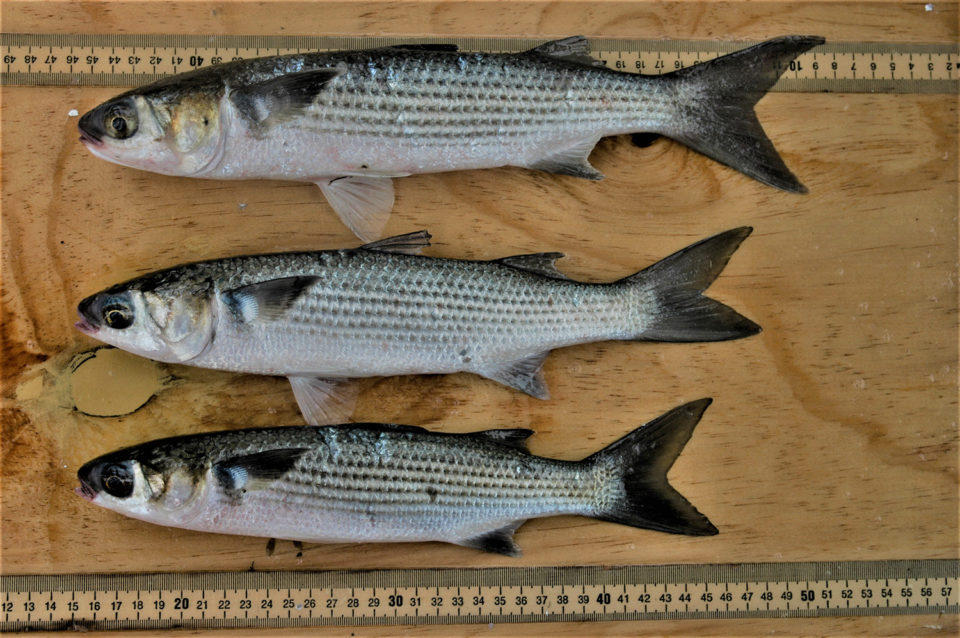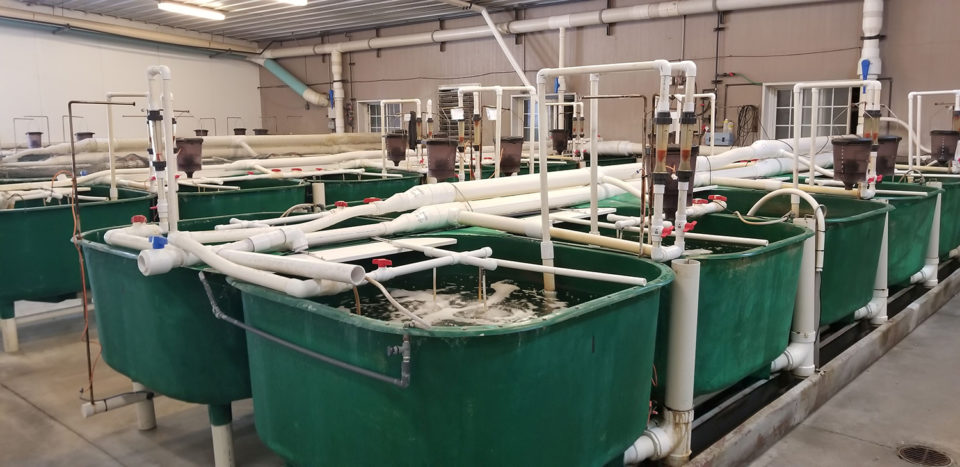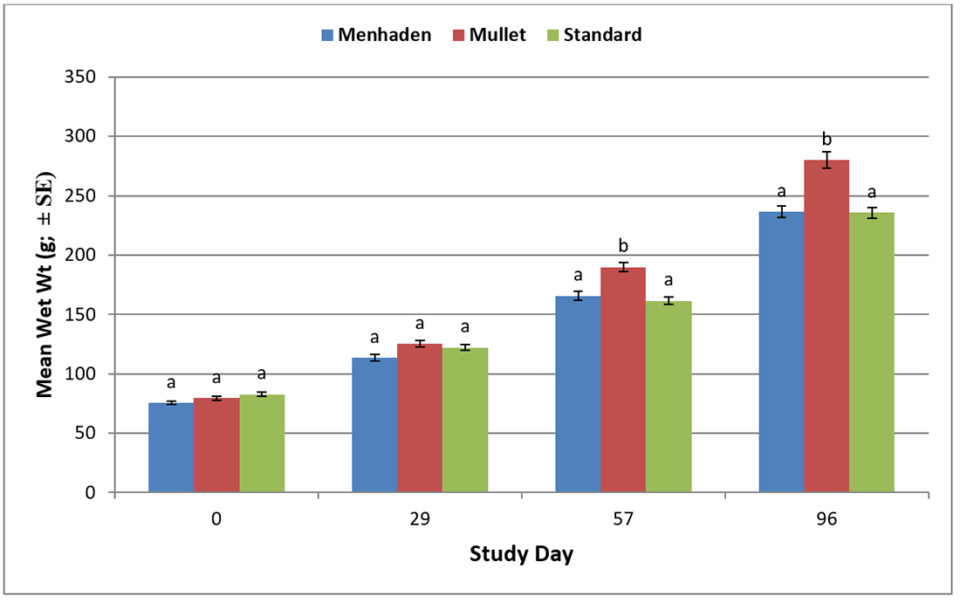Mote Marine Laboratory team explores sustainable fish feed for marine and freshwater aquaculture

Global seafood consumption is rapidly growing and is predicted to continue to increase for the next two decades. Aquaculture already provides more than half of the seafood produced for human consumption; therefore, increases in seafood consumption and demand will require aquaculture production to increase as well. Increasing aquaculture production will result in increased demand for fishmeal and the production of feeds for aquaculture is already the most rapidly expanding market in the animal feed sector.
Fishmeal is an essential component of aquaculture feeds. For many commercially raised aquaculture species, fishmeal is considered the primary and required source of protein due to its relatively complete amino acid profile. Most commercial aquaculture diets for finfish contain at least some quantity of fishmeal.
The majority of fishmeal is produced from capture fisheries, predominantly from species such as anchovies, menhaden, sardines and herrings. These pelagic forage species not only provide an excellent source of protein for animal feeds, they are also directly consumed by humans and utilized as bait fish. However, the supply of fishmeal from these species is not endless and the success of these species is a crucial component of the marine web food chain.
Scientists at Mote Marine Laboratory (Sarasota, Florida, USA) worked with local seafood leaders, with funding from the Gulf Coast Community foundation, to utilize an abundant non-traditional species, striped mullet (Mugil cephalus), as a potential source of valuable fishmeal. In 2014, mullet represented the largest commercial fishery by weight in Florida with up to 9 million pounds harvested (over 5 million pounds were harvested in southwest Florida). However, much of the commercial harvest is focused on the roe market, for which ovaries are extracted from females during the spawning season to produce an expensive and highly sought-after product known as bottarga.
Mullet roe represents one of the largest exports from southwest Florida with up to 1 million pounds being removed and shipped overseas. However, since the market value for bottarga is substantially greater than for mullet flesh (fish filet quality is not high value during the spawning season), mullet flesh is either discarded or used as bait. This creates an opportunity to use the otherwise underutilized mullet resource as a potential alternative fishmeal to the predominate forage species described above.
Scientists from Mote Marine Laboratory worked with fishermen to obtain mullet and with a commercial feed company (Zeigler Bros., Inc., Gardners, Pa., USA) to formulate and manufacture mullet- and menhaden-based fishmeal diets; these diets were used to evaluate the efficacy of mullet meal in feeding trials with two valuable aquaculture species.
The first feed study trial was completed with juvenile Siberian sturgeon (Acipenser baerri), a freshwater fish typically raised for its valuable caviar and meat products. The second feed study trial was done with redfish (Sciaenops ocellatus), a commercially proven marine aquaculture species. Both species have been grown in the land-based, sustainable recirculating aquaculture systems (RAS) tanks located at Mote Aquaculture Research Park (MAP) in Sarasota, Fla.
Three diets were evaluated in replicated tank trials with a freshwater and marine fish species. These species were fed a control diet, a menhaden-based fishmeal diet and a mullet-based fishmeal diet. The control diet for each feeding trial was a standard commercially available diet used for commercial production of sturgeon and redfish being grown at MAP. The menhaden-based fishmeal diet was an open formulation diet that utilized menhaden in the fishmeal and oil component. The mullet-based fishmeal diet had the same formulation as the menhaden diet, with the exception that the fishmeal component of the diet was mullet-based.

Results – Phase 1: Siberian sturgeon
Throughout the trial, we observed excellent growth, feed conversion ratios (FCRs), condition factors and survival across all feed treatments (Table 1). Statistical analysis revealed no significant difference (p>0.05) in any performance parameters among the three diets.
Juveniles approximately quadrupled in weight after 11 weeks (Fig. 1). FCRs were very similar for fish in all three diet treatments, ranging from 1.2:1 in the menhaden diet, to 1.25:1 in the mullet diet, to 1.35:1 in the standard control diet. Condition factors generally increased through the experimental trial. Mortality was 0 percent in the mullet treatment, 0.3 percent in the menhaden treatment, and 0.5 percent in the standard control diet. In addition, the gut microbiome of sturgeon fed the mullet diet contained higher abundances of beneficial bacteria associated with production of antioxidants, vitamin B12 and antimicrobial effects.
Waldrop, mullet, Table 1
| Diet | Initial weight (g) | Final weight (g) | SGR | FCR |
|---|
Diet | Initial weight (g) | Final weight (g) | SGR | FCR |
|---|---|---|---|---|
| Mullet fishmeal | 67.31 ± 2.01 | 218.88 ± 3.89 | 1.53 | 1.25 |
| Menhaden fishmeal | 61.41 ± 2.44 | 214.39 ± 3.89 | 1.62 | 1.20 |
| Control | 65.06 ± 2.53 | 199.27 ± 8.33 | 1.45 | 1.35 |

Results – Phase 2: Redfish
Similar to results in Phase 1, we observed excellent growth, survival and FCRs across all feed treatments (Table 2). Juvenile redfish tripled or quadrupled in weight during the 12-week feed trial (Fig. 2). However, unlike the Phase 1 trial, where all diets performed well with no significant difference in fish production performance, in the Phase 2 trial, the mullet-based fishmeal diet clearly performed better than the menhaden or control diets. Statistical analysis of growth data revealed a highly significant difference in mean wet weight among the three diets (ANOVA procedure, among treatments df=2, F=8.262, p=0.009), and Tukey’s post-hoc procedures revealed the mean weight of the mullet-fed redfish was significantly higher than that of the other two diet treatments.
Specific growth rates (SGR) and thermal growth coefficients (TGC) were also significantly higher in mullet-fed redfish. FCR results indicated more efficient food conversion in fish fed the mullet diet (Table 2). The gut microbiome also harbored different bacteria, which suggested an increase in mutualistic relationships, including bacterial taxa that aid in food digestion and may increase the nutrient availability to marine fish fed a mullet-based fishmeal diet.
Waldrop, mullet, Table 2
| Diet | Initial weight (g) | Final weight (g) | SGR | FCR |
|---|
Diet | Initial weight (g) | Final weight (g) | SGR | FCR |
|---|---|---|---|---|
| Mullet fishmeal | 79.43 ± 1.78 | 280.28 ± 7.02* | .891* | 1.34* |
| Menhaden fishmeal | 75.65 ± 1.64 | 236.58 ± 4.97 | .801 | 1.55 |
| Control | 82.15 ± 1.75 | 235.67 ± 4.65 | .682 | 1.71 |

Perspectives
Results from our feed trials clearly indicate that mullet-based fishmeal can be substituted for traditional fishmeal resources and provide an alternative to collection of menhaden or other fishmeal resources. In the Phase 1 trial with a freshwater fish species (Siberian sturgeon), there was no significant difference in fish growth and survival between mullet- and menhaden-based diets or the standard commercial diet. This feed did not impact growth performance or survival during the fingerling phase of sturgeon production.
In the Phase 2 trial with a marine aquaculture species (redfish), the mullet-based fishmeal diet showed even more promise. Fish fed the mullet diet outperformed fish fed the other two diets in terms of growth performance (growth, FCR, etc.) during the fingerling phase of redfish production.
The success of the feed trials is not measured by simply the best growth and performance; the real success is that the mullet-based fishmeal diets performed as well or better than the standard and menhaden-based diets. This study demonstrates the potential to use the mullet-based fishmeal as an alternative fishmeal resource. Hopefully, this will motivate other seafood communities and aquaculture producers to identify potential sources of valuable fishmeal and alternative protein sources.
Acknowledgements: This research was supported by the Gulf Coast Community Foundation. Additional technical support was provided by Pete Nicklason, Ziegler Brothers, Inc. (Craig Browdy, Mihai Sun, Tim Markey), and the Chiles Restaurant Group (Ed Chiles). The authors also thank Mel Kestner, Matthew Resley, Michael Nystrom, Nicole Rhody and Paula Caldentey.
Now that you've finished reading the article ...
… we hope you’ll consider supporting our mission to document the evolution of the global aquaculture industry and share our vast network of contributors’ expansive knowledge every week.
By becoming a Global Seafood Alliance member, you’re ensuring that all of the pre-competitive work we do through member benefits, resources and events can continue. Individual membership costs just $50 a year. GSA individual and corporate members receive complimentary access to a series of GOAL virtual events beginning in April. Join now.
Not a GSA member? Join us.
Authors
-
Thomas Waldrop
Senior Biologist
Mote Aquaculture Research Park
874 WR Mote Way
Sarasota, FL 34240 USA -
Dr. Kevan Main
Senior Scientist and Program Manager
Mote Marine Laboratory
1600 Ken Thompson Parkway
Sarasota, FL 34236 USA -
Dr. Andrea Tarnecki
Staff Scientist
Mote Marine Laboratory
1600 Ken Thompson Parkway
Sarasota, FL 34236 USA -
Dr. Nathan Brennan
Staff Scientist
Mote Marine Laboratory
1600 Ken Thompson Parkway
Sarasota, FL 34236 USA -
Edward Boggis
Staff Biologist
Mote Marine Laboratory
1600 Ken Thompson Parkway
Sarasota, FL 34236 USA
Tagged With
Related Posts

Aquafeeds
Fish oil alternatives are waiting in the wings
The Future of Fish Feed (F3) initiative aims to jumpstart innovation in terms of viable fish-free substitutes to fish oil through the global F3 Fish Oil Challenge.

Aquafeeds
It takes guts to advance sustainability in aquaculture
With byproducts representing between 25 to 50 percent of the weight of various fish species, we need to be looking at how the entire fish is being used: even the heads, guts and skin.

Intelligence
As sturgeon farming grows, demand concerns emerge
Caviar, or lightly salted sturgeon roe, has been enjoyed for centuries as an expensive gourmet delicacy. After a drastic decline in wild sturgeon stocks, aquaculture stepped in to fill the void. But can farmed supply find lasting balance with market demand?

Health & Welfare
U.S. field trials show promise for mullet farming in polyculture
Field trails in Alabama, USA, demonstrated the potential of raising striped mullet with Pacific white shrimp in inland ponds. Using wild-caught fingerlings at low density, the trials found the same survival rates as for mullet and shrimp grown separately.


